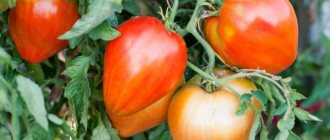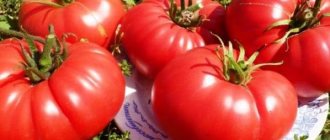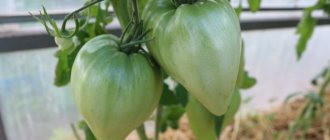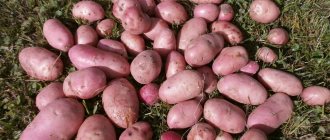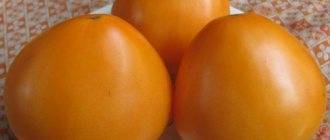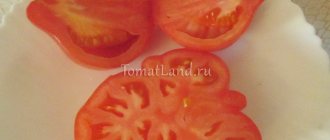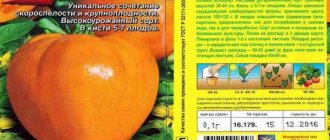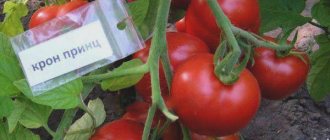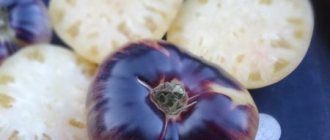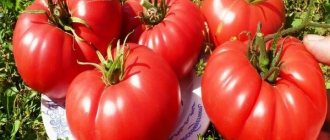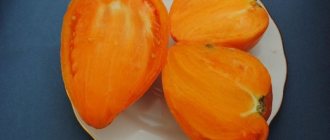Description of the tomato variety Bull's Heart Golden
The growing season is 110-120 days from the appearance of the first shoots. The hybrid is mid-season, large-fruited. The culture belongs to the determinant type of tomatoes.
The Bull's Heart bush is powerful, with medium foliage, reaches 1-1.5 m in height
Description of fruits
In the variety Bull's Heart Golden, the fruits reach large sizes as they ripen. The weight of each tomato varies from 400 to 600 g. There are specimens whose weight is 1000 g.
Important! The largest tomatoes ripen on the first bunches. Subsequent ovaries are smaller, the weight of the fruit varies from 50 to 100 g.
The color of tomatoes changes from green to golden yellow as they ripen.
The color of tomatoes changes from green to golden yellow as they ripen.
The tomatoes are cone-shaped or heart-shaped, with dense thin skin. There is a slight ribbing near the stalk. The core of the fruit is yellow, fleshy, but not fibrous, with small seed chambers.
The Ox's Heart Golden tomatoes taste very juicy and velvety. When consumed, you can note the pronounced sweetness of the tomatoes with a slight sourness.
Characteristics of tomato Bull's heart Golden
The variety can be cultivated both in open ground and using greenhouses. In regions with hot and long summers, gardeners successfully grow the Bull's Heart Golden tomato in garden beds. In the northern regions, it is recommended to provide tomatoes with greenhouse conditions.
Productivity and fruiting
The variety is mid-season: tomatoes ripen 100-117 days after planting. There are 3-5 tomatoes on each brush. The first wave of the harvest is larger than subsequent ones.
From 1 m2 on average you can harvest 13-15 kg of Bull's Heart Golden tomatoes.
With proper care and favorable weather conditions, the maximum indicators are 20 kg per 1 m2
Violation of the rules of agricultural technology has a negative effect on the yield: with a lack of nutrients, the fruits ripen smaller. If you plant bushes in a different pattern, the tomatoes will ripen more slowly.
Area of application of fruits
Tomatoes Bull's Heart Golden are more often used for preparing salads, since the first fruits of the variety are large. Smaller tomatoes are suitable for whole-fruit canning.
Vegetables are rarely used for preserving tomato paste and juices because of their color. Tomatoes are not suitable for sale and long-term transportation: their skin is thin and easily damaged.
Resistance to diseases and pests
The Bull's Heart Golden variety is characterized by a strong immune system. With improper care or unfavorable natural conditions, the variety can be affected by fungal diseases.
At high humidity there is a risk of brown spot development. Symptoms often appear during flowering or fruiting.
It can be recognized by round yellowish spots located on the upper part of the leaf blade. There is a brown coating on its reverse side. Without treatment, the above-ground part of the bush dries out and the tomato dies.
If you plant crops close to each other in soil contaminated with fungi, then with high humidity, root rot may develop.
The stem of the diseased tomato Bull's Heart Golden darkens and becomes thinner. The plant quickly dies.
More often, root rot occurs in greenhouses, where it is humid and hot.
Diseases and pests
The tomato is moderately resistant to typical tomato diseases. But as a preventive measure, bushes are sprayed with preparations enriched with copper. If darkened or curled tomato leaves appear, spray Fitosporin or another biological preparation. Affected parts of the plant must be removed and destroyed.
The variety is most attacked by thrips, aphids, spider mites and whiteflies. Insecticides are used against pests. You can also resort to folk remedies: a solution of ammonia, an infusion of onion peels, or a decoction of celandine. To prevent diseases and pests from spreading, you must:
- Ventilate the greenhouse structure;
- Destroy weeds;
- Observe the watering regime;
- Mulch the soil with humus or peat.
Advantages and disadvantages
The variety is known among gardeners as high-yielding and large-fruited. People are also attracted by the unusual, rich yellow color of the skin of the Bull's Heart Golden tomatoes.
Tomatoes have practically no seeds, tender pulp and a balanced taste - sweet, sugary, with a hint of sourness.
pros
- resistance to heat; the possibility of growing crops in all regions of Russia;
- ease of care;
- extended fruiting period; vegetables can be harvested from June until frost.
Minuses
- fruits do not tolerate long-term transportation;
- tomatoes crack when hit because the skin is very thin;
- the bush needs a garter.
And although the first ripened tomatoes cannot be used for whole-fruit canning due to their size, the second wave of the harvest will be smaller, and therefore suitable for processing.
Features of cultivation
The seedling cultivation period is 50-65 days, so all sowing procedures are carried out in mid-March.
Containers should be washed and dried. You need to make sure that there are ventilation holes in them.
Tomato seeds are processed by the manufacturer and therefore do not require disinfection.
Landing algorithm:
- Fill the soil with soil.
- Make furrows up to 1-1.5 cm deep.
- Spread the seed and sprinkle it with soil.
- Moisten the soil mixture.
- Cover the container with glass or cling film.
Until the seeds have sprouted, the room temperature should be maintained at 21-23 °C. As soon as shoots are noticeable, remove the cover. Plant the seedlings after the true leaves appear.
During picking, the integrity of the earthen coma should be preserved as much as possible in order to speed up the rooting process
Two weeks before transferring the seedlings to a permanent place, harden the Bull's Heart Golden tomatoes. The container with tomatoes must be taken outside, gradually increasing their time spent outdoors.
Landing algorithm:
- Prepare holes according to the 50*70 cm pattern.
- Carefully remove the tomato, preserving the earthen lump as much as possible, and then move it to the hole.
- Cover the seedling with soil and compact the soil mixture around it.
- Water the tomatoes generously Bull's Heart Golden.
Important! The optimal time for the procedure is early morning or evening. It is allowed to plant tomatoes in cloudy weather.
A mandatory step in caring for tall tomatoes is gartering. Immediately after planting, you should build a trellis by digging support pillars on the sides of the bed. Stretch a wire between the tops.
Each of the tomatoes should be carefully tied to the trellis with a rope or twine
Important! You need to tie up the shoots as they grow throughout the season, carefully distributing them so that they do not get tangled or fall.
It is recommended to form a tomato Bull's heart Golden into one stem
The variety begins to lay flowers after 9-12 leaf blades. Brushes are formed every three sheets.
Stepchildren must be removed throughout the season, carrying out the manipulation in the morning. Shoots whose length does not exceed 7 cm must be pruned.
When removing stepchildren, it is important to leave a “stump”
To get a good harvest, it is recommended to fertilize:
- The first procedure is 10-15 days after planting, use organic fertilizers.
- During the flowering period, give preference to mineral compositions containing potassium and phosphorus.
- After fruit set, superphosphate is added to the bed to speed up ripening.
The crop should be watered regularly, alternating the procedure with loosening. After the plant takes root and grows, it is recommended to mulch the tomato bed with grass or sawdust.
How to grow healthy and high-yielding tomatoes
Bull's heart tomatoes do not ripen quickly and have a long growing season. To speed up harvesting and prevent the development of late blight, which affects late varieties, tomatoes are grown in seedlings.
Preparation of seed material
Tomato seeds are disinfected and hardened. A plastic bag is filled with water and placed in the freezer. The resulting ice is placed in a glass container, heated to 20-25° and the seed is soaked in it for 10-12 hours.
100 ml of water is combined with 1 g of potassium permanganate, and tomato grains are disinfected in this solution for 40-50 minutes.
Optimal soil composition for tomatoes Ox Heart
It is possible to grow healthy and strong seedlings only in a fertile, loose substrate. Adult tomatoes also need this soil. Sandy or clay soil needs to be fed:
- mineral complexes,
- peat,
- rotted manure,
- humus.
The substrate for seedlings is made in advance, disinfected by pouring boiling water on it, calcining it in the oven or freezing it. Prepare the soil by mixing leaf soil:
- with perlite that absorbs moisture;
- with coarse sand that loosens the soil;
- with humus rich in nutrients.
Attention: do not add fresh manure or leaves to the substrate for tomato seedlings. Organic matter releases heat and absorbs nitrogen, which leads to the death of fragile plants.
Timing and technology of sowing seedlings
The seeds of Ox's Heart are sent to the substrate in early March, so that after 50-70 days the tomato bushes can be moved to an open bed or transplanted into a greenhouse. You should not sow mid-late tomatoes earlier.
A plastic container or box is filled with soil and watered with warm water. Every 30 mm, lay out tomato seeds, deepen them 2 cm with a pencil or tweezers, and sprinkle with soil. The box is covered with glass or plastic film and left in a bright and warm room.
Pest and disease control
To prevent the Bull's Heart Golden variety from being susceptible to fungal diseases, preventive measures should be taken:
- dig up the area in autumn and spring;
- disinfect the soil before planting seedlings;
- purchase seed only from trusted suppliers.
If signs of root rot appear, measures should be taken to dry the soil: loosen it, cover it with sand. Sprinkle the soil mixture with a weak solution of manganese to disinfect.
In the later stages, the Golden Bull's Heart tomato cannot be cured. The bush is subject to destruction; preventive measures are taken in relation to other plants.
Remedies containing copper are effective against olive spot. It is recommended to treat the bushes with Barrier or Barrier.
Further care of tomato beds
In order for the variety to please you with large tomatoes, the plants need to be carefully cared for, pollinated, and protected from diseases and parasites.
Watering mode
Although the tomato can withstand drought, the plantings are irrigated once or twice a week, but abundantly. Warm water is applied at the root. During the period of ovary formation, in hot and dry weather, tomatoes are watered more often.
Feeding bushes
Even when Oxheart is planted in fertile soil, the plant needs nutrients. Organic fertilizers are applied to the soil:
- 14-15 days after planting the bushes in a permanent place.
- After 10 days from the laying of the first fruits.
- During the ripening of tomatoes.
2 liters of liquid manure are poured under one plant. Tomato responds well to mineral complexes.
Formation
When the bushes take root and get stronger, leave 1 or 2 stems with 7-8 tassels, remove all others.
Stepsoning
Side shoots are regularly plucked off, otherwise the tomatoes will not be large. The shoots need to be pinched once every 10 days at a level of 10 mm from the leaf sinus. Tomatoes spend a lot of energy on the development of stepsons, instead of directing it to the formation and ripening of fruits.
Tying up
The branches of the bushes break under the weight of the tomatoes, so the rooted seedlings are secured to the support with clamps, scraps of fabric, or tied with old nylon stockings or tights.
Mulching and loosening the soil
In hot weather, moisture evaporates quickly. To delay it, after irrigation or rain, cover the soil under the bushes:
- peat,
- sawdust,
- straw,
- pine needles
- spunbond,
- agrofibre.
Important: the soil under the tomatoes is loosened and hilled several times a season. Such procedures help strengthen the roots and improve the supply of nutrients.
Pollination
When growing the Ox Heart variety in a greenhouse, it is recommended to gently shake the branches of the bushes in the mornings and evenings to help the flowers pollinate. In an open garden bed, this work is performed by the wind, bumblebees, and bees.
Protection and treatment of bushes
Tomatoes are rarely affected by late blight, which affects many varieties of late tomatoes, but in damp and rainy weather fungi are activated, causing the development of the disease. To prevent infection, the bushes are treated with Bordeaux mixture or a solution prepared from whey and iodine.
When signs of late blight appear, the diseased plant is pulled out, and healthy tomatoes are sprayed with fungicides - “Gamair”, “Late blight”.
The voracious larvae of the Colorado potato beetle feast on tomato leaves. The pest can be controlled using contact insecticides.
Whitefly infestation poses a danger to tomatoes. Garlic infusion repels insects.
If there is a mole cricket in the area that lays hundreds of eggs in the ground, a decoction of hot pepper is poured into the nest.
